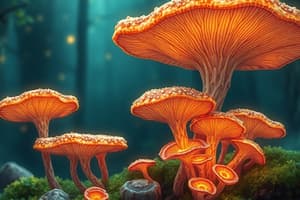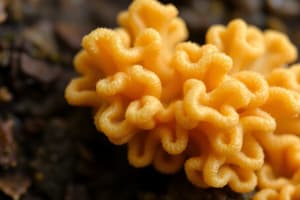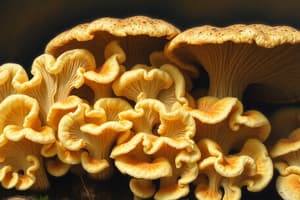Podcast
Questions and Answers
What is the term used for a mass of hyphae?
What is the term used for a mass of hyphae?
- Mycelium (correct)
- Mushroom
- Filament
- Spore
What are the cross-walls in hyphae called?
What are the cross-walls in hyphae called?
- Cortex
- Septae (correct)
- Filaments
- Capsules
What is the primary function of the gaps in the cross-walls of hyphae?
What is the primary function of the gaps in the cross-walls of hyphae?
- Protection from pathogens
- Storing energy
- Reproduction
- Facilitating nutrient movement (correct)
Mycelia persistently grow towards which regions?
Mycelia persistently grow towards which regions?
Which of the following statements is true about the body shape of a fungus?
Which of the following statements is true about the body shape of a fungus?
What are fungal cell walls primarily composed of?
What are fungal cell walls primarily composed of?
Which process do fungi use to break down food before absorption?
Which process do fungi use to break down food before absorption?
What is a primary distinction in where animals perform digestion compared to fungi?
What is a primary distinction in where animals perform digestion compared to fungi?
What are the two growth forms of fungi mentioned?
What are the two growth forms of fungi mentioned?
Which characteristic separates fungi from other organisms regarding their ability to digest chitin?
Which characteristic separates fungi from other organisms regarding their ability to digest chitin?
What defines the major clades within fungi?
What defines the major clades within fungi?
Which of the following statements about spore production is correct?
Which of the following statements about spore production is correct?
What is the reproductive stage of the fungal life cycle commonly referred to as?
What is the reproductive stage of the fungal life cycle commonly referred to as?
What characteristic do all modern terrestrial fungi share?
What characteristic do all modern terrestrial fungi share?
How does sexual reproduction typically occur in fungi?
How does sexual reproduction typically occur in fungi?
Which fungi group is NOT correctly matched with its defining characteristic?
Which fungi group is NOT correctly matched with its defining characteristic?
What is a common feature of the fruiting bodies in both Basidiomycota and Ascomycota?
What is a common feature of the fruiting bodies in both Basidiomycota and Ascomycota?
What distinguishes the two steps of fungal reproduction?
What distinguishes the two steps of fungal reproduction?
What is the primary organism infected by chytridiomycosis?
What is the primary organism infected by chytridiomycosis?
What role do chytrids play in their global spread?
What role do chytrids play in their global spread?
Which species is primarily associated with White Nose Syndrome?
Which species is primarily associated with White Nose Syndrome?
What is a common outcome of fungal infections in skin diseases?
What is a common outcome of fungal infections in skin diseases?
Which of the following correctly describes the impact of fungi on the carbon cycle?
Which of the following correctly describes the impact of fungi on the carbon cycle?
What is one key benefit that plants receive from their association with mycorrhizal fungi?
What is one key benefit that plants receive from their association with mycorrhizal fungi?
Which statement best describes the relationship between ectomycorrhizal fungi and plants?
Which statement best describes the relationship between ectomycorrhizal fungi and plants?
What is a defining characteristic of lichens?
What is a defining characteristic of lichens?
What significant role did mycorrhizal fungi likely play in the early evolution of land plants?
What significant role did mycorrhizal fungi likely play in the early evolution of land plants?
Approximately what fraction of land plants today live in physical contact with fungi?
Approximately what fraction of land plants today live in physical contact with fungi?
Which type of mycorrhizal fungi forms structures that penetrate the root cells of plants?
Which type of mycorrhizal fungi forms structures that penetrate the root cells of plants?
What crucial ability may have contributed to the success of early land plants associated with mycorrhizal fungi?
What crucial ability may have contributed to the success of early land plants associated with mycorrhizal fungi?
In some lichens, what additional component has been discovered to be part of their structure?
In some lichens, what additional component has been discovered to be part of their structure?
What percentage of individuals infected with Valley Fever typically show no symptoms?
What percentage of individuals infected with Valley Fever typically show no symptoms?
Which of the following is a primary risk associated with eating the Death Cap Mushroom?
Which of the following is a primary risk associated with eating the Death Cap Mushroom?
What is the main challenge in treating infections caused by Valley Fever?
What is the main challenge in treating infections caused by Valley Fever?
What type of trees is the Death Cap Mushroom commonly associated with in California?
What type of trees is the Death Cap Mushroom commonly associated with in California?
Which of the following describes the structure of yeast in fungi?
Which of the following describes the structure of yeast in fungi?
In which reproductive phase does karyogamy occur in the fungal life cycle?
In which reproductive phase does karyogamy occur in the fungal life cycle?
What is a significant characteristic that distinguishes Ascomycota from Basidiomycota?
What is a significant characteristic that distinguishes Ascomycota from Basidiomycota?
Which of the following features is a key identifier of the Death Cap Mushroom?
Which of the following features is a key identifier of the Death Cap Mushroom?
Flashcards
Chitin
Chitin
A long-chain polymer that makes up the cell walls of fungi, providing structural support.
Extracellular Digestion
Extracellular Digestion
The process where fungi break down food outside their cells, releasing enzymes that digest it, and then absorb the broken-down nutrients.
Hyphae
Hyphae
Long, thread-like filaments that make up the body of a fungus. They can form complex networks called mycelia.
Mycelia
Mycelia
Signup and view all the flashcards
What type of digestion do fungi use?
What type of digestion do fungi use?
Signup and view all the flashcards
Septa
Septa
Signup and view all the flashcards
Pore
Pore
Signup and view all the flashcards
How does the body shape of a fungus change?
How does the body shape of a fungus change?
Signup and view all the flashcards
Fungal ancestors
Fungal ancestors
Signup and view all the flashcards
What are synapomorphies?
What are synapomorphies?
Signup and view all the flashcards
What is a fruiting body?
What is a fruiting body?
Signup and view all the flashcards
Basidiomycota spores
Basidiomycota spores
Signup and view all the flashcards
Ascomycota spores
Ascomycota spores
Signup and view all the flashcards
What is a mating type?
What is a mating type?
Signup and view all the flashcards
What are the two steps of sexual reproduction in fungi?
What are the two steps of sexual reproduction in fungi?
Signup and view all the flashcards
What is mutualism?
What is mutualism?
Signup and view all the flashcards
What is parasitism?
What is parasitism?
Signup and view all the flashcards
Mycorrhizal fungi
Mycorrhizal fungi
Signup and view all the flashcards
What is the role of mycorrhizal fungi in plant evolution?
What is the role of mycorrhizal fungi in plant evolution?
Signup and view all the flashcards
Ectomycorrhizal fungi
Ectomycorrhizal fungi
Signup and view all the flashcards
Endomycorrhizal fungi
Endomycorrhizal fungi
Signup and view all the flashcards
Lichens
Lichens
Signup and view all the flashcards
What do lichens provide for the environment?
What do lichens provide for the environment?
Signup and view all the flashcards
What does Chytridiomycosis infect?
What does Chytridiomycosis infect?
Signup and view all the flashcards
What are the main causes of death in Chytridiomycosis?
What are the main causes of death in Chytridiomycosis?
Signup and view all the flashcards
What does White Nose Syndrome infect?
What does White Nose Syndrome infect?
Signup and view all the flashcards
What does Cordyceps fungus infect?
What does Cordyceps fungus infect?
Signup and view all the flashcards
How do fungi play a crucial role in the Carbon Cycle?
How do fungi play a crucial role in the Carbon Cycle?
Signup and view all the flashcards
Valley Fever
Valley Fever
Signup and view all the flashcards
Coccidioides
Coccidioides
Signup and view all the flashcards
Death Cap Mushroom
Death Cap Mushroom
Signup and view all the flashcards
Amanita phalloides
Amanita phalloides
Signup and view all the flashcards
Mycorrhizal Fungi (MF)
Mycorrhizal Fungi (MF)
Signup and view all the flashcards
Arbuscular mycorrhizal fungi
Arbuscular mycorrhizal fungi
Signup and view all the flashcards
Fungal feeding
Fungal feeding
Signup and view all the flashcards
Study Notes
Fungi: Introduction
- Fungi are closely related to animals, evidenced by DNA sequence data, similar chitin synthesis, flagella structure, and glycogen storage.
- Fungi have two growth forms: single-celled yeasts and multicellular filamentous forms (mycelia).
- Fungi perform extracellular digestion, secreting enzymes to break down food outside their bodies, and then absorbing the digested compounds.
Fungal Cell Walls & Extracellular Digestion
- Fungal cell walls are composed of chitin.
- Most animals cannot digest chitin without bacterial symbionts.
- Extracellular digestion is when digestion occurs outside the organism.
Hyphae
- Hyphae are long, narrow filaments that make up a mycelium.
- Septa are cross-walls that divide hyphae into cells, with pores allowing rapid nutrient flow.
- Mycelia are composed of hyphae and are the main body of most fungi.
Major Clades of Fungi
- Groups are defined by unique characteristics.
- Fungal ancestors were related to animals or both had unique traits.
- Terrestrial fungi evolved structures like fruiting bodies for spore dispersal.
Fungi and Symbiosis
- Fungi form mutualistic relationships with other organisms, such as mycorrhizal fungi that associate with plant roots.
- Mycorrhizal fungi increase nutrient uptake for the plant, and receive carbon compounds in return.
- Endomycorrhizal fungi are called arbuscular mycorrhizal fungi.
- Lichens are a symbiotic association of fungi and photosynthetic partners (algae or cyanobacteria).
Fungi and Reproduction
- Fungi reproduce sexually and asexually.
- Fungi reproduce using fruiting bodies that create masses of spores.
- In sexual reproduction, plasmogamy (fusion of cytoplasm) and karyogamy (fusion of nuclei) are the two steps leading to the formation of a zygote diploid structure.
Fungi: Body Forms
- Crustaceous lichens are in contact with the substrate.
- Foliose lichens are flat and not in contact with the substrate.
- Fruticose lichens are shrub-like.
Fungal Diseases
- Chytridiomycosis is a skin disease that infects amphibians.
- White Nose Syndrome infects bats.
- Valley Fever is caused by inhaled fungal spores.
- Death Cap Mushroom is a deadly mushroom from Europe, and has similar characteristics to other edible species but is extremely toxic.
Importance of Fungi
- Fungi are saprophytes that break down dead organisms, playing a key role in the carbon cycle.
- Some fungi cause human diseases, like athlete's foot and ringworm.
Studying That Suits You
Use AI to generate personalized quizzes and flashcards to suit your learning preferences.




